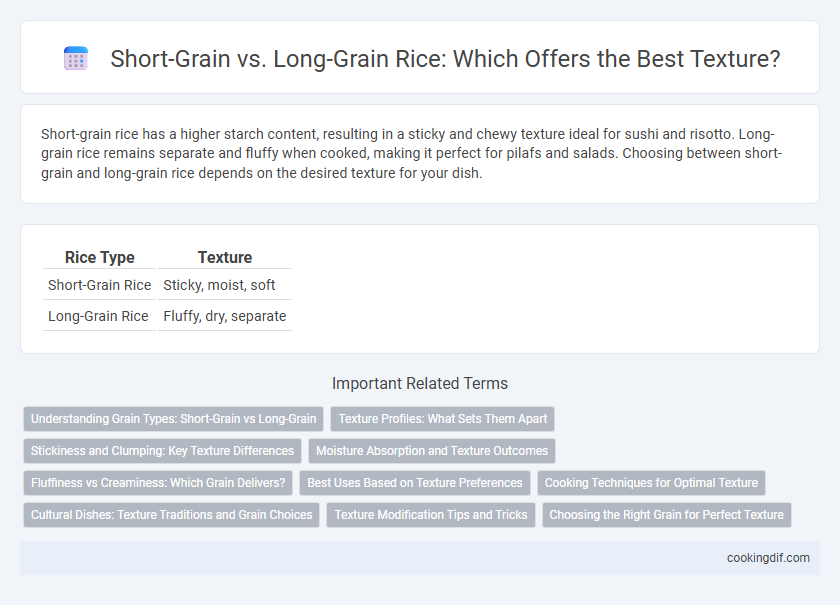Short-grain rice has a higher starch content, resulting in a sticky and chewy texture ideal for sushi and risotto. Long-grain rice remains separate and fluffy when cooked, making it perfect for pilafs and salads. Choosing between short-grain and long-grain rice depends on the desired texture for your dish.
Table of Comparison
| Rice Type | Texture |
|---|---|
| Short-Grain Rice | Sticky, moist, soft |
| Long-Grain Rice | Fluffy, dry, separate |
Understanding Grain Types: Short-Grain vs Long-Grain
Short-grain rice is characterized by its plump, round grains that release more starch, resulting in a sticky and chewy texture ideal for sushi, risotto, and rice puddings. Long-grain rice has slender, elongated grains with lower starch content, producing a light, fluffy, and separate texture preferred in pilafs, biryanis, and stir-fries. Understanding these grain types helps in selecting the right rice for specific culinary applications based on desired texture and cooking properties.
Texture Profiles: What Sets Them Apart
Short-grain rice boasts a soft, sticky texture with high amylopectin content, making it ideal for dishes requiring clumping, such as sushi and risotto. Long-grain rice features a firm, fluffy texture due to its higher amylose levels, ensuring separate, non-sticky grains perfect for pilafs and biryanis. The distinct starch composition drives these texture profiles, influencing cooking methods and culinary applications.
Stickiness and Clumping: Key Texture Differences
Short-grain rice is characterized by its high amylopectin content, resulting in a sticky texture that causes grains to clump together, ideal for dishes requiring cohesion like sushi or risotto. Long-grain rice contains more amylose, making it less sticky and resulting in fluffy, separate grains perfect for pilafs or stir-fries. The stickiness and clumping behavior directly impact the textural outcome and suitability of rice varieties in culinary applications.
Moisture Absorption and Texture Outcomes
Short-grain rice absorbs more moisture during cooking, resulting in a stickier, softer texture ideal for sushi or risotto. Long-grain rice retains a firmer, drier texture due to lower moisture absorption, making it perfect for pilafs and side dishes. The amylopectin content in short-grain rice is higher, causing this distinctive stickiness compared to the higher amylose in long-grain varieties.
Fluffiness vs Creaminess: Which Grain Delivers?
Short-grain rice boasts a higher starch content, resulting in a creamy, sticky texture perfect for dishes like sushi or risotto. Long-grain rice contains less amylopectin, delivering a fluffy, separate grain ideal for pilafs or biryanis. Choosing between short-grain and long-grain rice hinges on desired texture--creamy cohesion versus light fluffiness.
Best Uses Based on Texture Preferences
Short-grain rice offers a sticky and tender texture ideal for sushi, risotto, and rice pudding, where clumping is preferred. Long-grain rice provides a fluffy and separate grain texture perfect for pilafs, biryanis, and stir-fries, ensuring each grain remains distinct. Texture preferences guide the choice between short-grain and long-grain rice depending on the desired dish consistency and mouthfeel.
Cooking Techniques for Optimal Texture
Short-grain rice has a higher starch content, resulting in a sticky, creamy texture perfect for risotto and sushi. Long-grain rice contains more amylose, producing a fluffy, separate grain ideal for pilafs and fried rice. Using precise water ratios and cooking times enhances the desired texture, such as simmering short-grain rice gently or rinsing long-grain rice to remove excess starch.
Cultural Dishes: Texture Traditions and Grain Choices
Short-grain rice, known for its sticky and tender texture, is essential in East Asian cuisines such as Japanese sushi and Korean bibimbap, where clumping grains facilitate picking with chopsticks. Long-grain rice, with its fluffy and separate kernels, dominates South Asian and Middle Eastern dishes like biryani and pilaf, complementing rich spices and promoting a distinct bite. Cultural rice selections hinge on preferred textures that enhance traditional eating experiences and ingredient pairings.
Texture Modification Tips and Tricks
Short-grain rice features a sticky, tender texture ideal for dishes requiring cohesion, while long-grain rice remains fluffy and separate when cooked. To modify texture, rinse short-grain rice thoroughly to reduce excess starch and achieve a slightly firmer bite, or soak it briefly to enhance softness. For long-grain rice, use precise water ratios and avoid over-stirring during cooking to maintain individual grain integrity and prevent mushiness.
Choosing the Right Grain for Perfect Texture
Short-grain rice has a higher starch content, resulting in a soft, sticky texture ideal for sushi and risotto, while long-grain rice features a lower starch level that produces fluffy, separate grains perfect for pilafs and salads. Selecting the right grain depends on the desired dish texture; short-grain enhances creaminess, whereas long-grain provides lightness and firmness. Understanding the starch composition and moisture retention of each type ensures consistent cooking results and texture accuracy.
Short-grain vs Long-grain for texture Infographic

 cookingdif.com
cookingdif.com